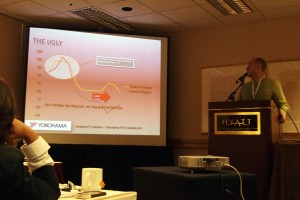Wednesday afternoon kicked off this year’s Institute of Business Forecasting & Planning’s Best Practices Conference with a near-standing room only pre-conference Demand Management Forum. The Forum was led by Mike Gilliand from SAS and a panel of experts who brought the group through three topics: (1) Applying demand management sensing, shaping and creating, (2) What management must know and (3) Worst practices in business forecasting. The forum touched on many key issues faced by demand planning and forecasting professionals, giving the group a taste of what’s to come over the next two days.
What makes this group so unique is that they are all demand planners. While they hail from different organizations they share in this specific role and are all part of a community dedicated to sharing and helping each other learn new techniques and working through challenges together. The last session, which was cheekily dubbed ‘a confessional’, had the panel and audience sharing stories of what didn’t work. Try to imagine a room of over 75 people openly sharing mistakes and what was a disaster in their organization. For me this was such a refreshing experience seeing heads nod throughout the room as each participant spoke of their woes and a fury of note taking as a panelist or fellow forum attendee would provide some solutions or ideas for how to alleviate the issue.
 Panelist Jonathon Karelse from Yokohama Tire shared a worst practices experience and led the group through his folly of using a collaborative forecasting system for tire demand that did not work. While this was a method he learned at a previous IBF event, it happened to be ill-executed at Yokohama and led to excess inventory because of the bull-whip effect and beer games. One might ask “What do beer and whips have to do with forecasting tire demand?” Jonathon explained the bull-whip effect that as the velocity of the end of the whip gets so high that once it hits its target and ‘snaps’ what you are hearing is the end actually breaking the sound barrier. He used this analogy to explain what happened to the errors in supply chain. The Beer Games reference eluded to an MIT experiment which showed that a lack of trust within an organization can cause too much inventory. The Lessons learned were that removing the effect can be done by getting closer to each piece of the supply chain (and Jonathon still has a job so it must be true).
Panelist Jonathon Karelse from Yokohama Tire shared a worst practices experience and led the group through his folly of using a collaborative forecasting system for tire demand that did not work. While this was a method he learned at a previous IBF event, it happened to be ill-executed at Yokohama and led to excess inventory because of the bull-whip effect and beer games. One might ask “What do beer and whips have to do with forecasting tire demand?” Jonathon explained the bull-whip effect that as the velocity of the end of the whip gets so high that once it hits its target and ‘snaps’ what you are hearing is the end actually breaking the sound barrier. He used this analogy to explain what happened to the errors in supply chain. The Beer Games reference eluded to an MIT experiment which showed that a lack of trust within an organization can cause too much inventory. The Lessons learned were that removing the effect can be done by getting closer to each piece of the supply chain (and Jonathon still has a job so it must be true).
A few other ideas that came up during discussions:
- Arbitrary forecast error targets – Why does your company shoot for 5%? Is that realistic? Perhaps a more sound approach would be to work towards continuous improvement and aiming to beat the standard forecast model.
- Location-product combination – Working to prioritize this combination is important. A 10% error in one location may not have the same impact and financial loss as the same error would cause in another location.
- Excess of meetings – Having too many meetings and reports takes too much time away from actually analyzing your forecast. Is your organization over-doing it by having the demand planner’s time split into too many directions?
- Backing into a number – Just don’t do it, whatever you do. This will come back to haunt you.
Today many of the panelists along with other demand planners attending the conference will give presentations that will go more in depth into challenges and solutions faced by those in the role of demand planner. Is it all for not? Anish Jain shared with the group some statistics found in collected data the IBF has accumulated over the years which shows that forecast accuracy has increased while inventory levels have remained the same. What does this mean? Are the forecasts being taken seriously? I imagine this is a topic that will be talked about more throughout the conference.
Maria E. Simos is CEO of e-forecasting.com, an economic research and consulting company based in Durham, NH with clients ranging from media, academics, federal banks, major manufacturers to other consulting firms. In her role, Ms. Simos works to further develop the reach of e-forecasting’s economic data and reporting capabilities. She also works closely with clients to ensure that they are receiving the important forecasts, economic data and support needed to be successful. She promotes the work of e-forecasting.com and provides economic analysis through her twitter account (@mesimos) and via other social media outlets. Ms. Simos holds a Master’s Degree in Management from Carnegie Mellon University where she focused her research on management and network analysis. Her research explored social and business networks and their tie in to culture in organizations. Her undergraduate study was completed at the Tepper School of Business at Carnegie Mellon.



